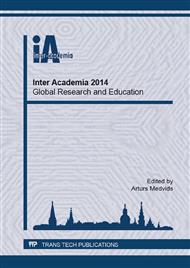[1]
Csurgay ÁI, Porod W, Rakos B. Signal processing by pulse-driven molecular arrays. International Journal of Circuit Theory and Applications 2003; 31: 55–66. DOI: 10. 1002/cta. 225.
DOI: 10.1002/cta.225
Google Scholar
[2]
Rakos B, Porod W, Csurgay ÁI. Computing by pulse-driven nanodevice arrays. Semiconductor Science and Technology 2004; 19: 472-474. DOI: 10. 1088/0268-1242/19/4/155.
DOI: 10.1088/0268-1242/19/4/155
Google Scholar
[3]
Rakos B. Simulation of Coulomb-coupled, protein-based logic. Journal of Automation, Mobile Robotics & Intelligent Systems 2009; 3(4): 46–48.
Google Scholar
[4]
Rakos B. Coulomb-coupled, protein-based computing arrays. Advanced Materials Research 2011; 222: 181-184. DOI: 10. 4028/www. scientific. net/AMR. 222. 181.
DOI: 10.4028/www.scientific.net/amr.222.181
Google Scholar
[5]
Rakos B. Modeling of dipole-dipole-coupled, electric field-driven, protein-based computing architectures. International Journal of Circuit Theory and Applications 2015; 43: 60-72. DOI: 10. 1002/cta. (1924).
DOI: 10.1002/cta.1924
Google Scholar
[6]
Xu D, Phillips JC, Schulten K. Protein response to external electric fields: relaxation, hysteresis, and echo. Journal of Physical Chemistry 1996; 100: 12108–12121. DOI: 10. 1021/jp960076a.
DOI: 10.1021/jp960076a
Google Scholar
[7]
Habuchi S, Ando R, Dedecker P, Verheijen W, Mizuno H, Miyawaki A, Hofkens J. Reversible single-molecule photoswitching in the GFP-like fluorescent protein Dronpa. Proceedings of the National Academy of Sciences 2005; 102(27): 9511-9516. DOI: 10. 1073/pnas. 0500489102.
DOI: 10.1073/pnas.0500489102
Google Scholar
[8]
Boneh D, Dunworth C, Lipton RJ, Sgall JI. On the computational power of DNA. Discrete Applied Mathematics 1996; 71: 79–94, DOI: 10. 1016/S0166-218X(96)00058-3.
DOI: 10.1016/s0166-218x(96)00058-3
Google Scholar
[9]
Benenson Y, Gil B, Ben-Dor U, Adar R, Shapiro E. An autonomous molecular computer for logical control of gene expression. Nature 2004; 429(6990): 423–429, DOI: 10. 1038/nature02551.
DOI: 10.1038/nature02551
Google Scholar
[10]
Stojanovic MN, Mitchell TE, Stefanovic D. Deoxyribozyme-Based Logic Gates. Journal of the American Chemical Society 2002; 124(14): 3555–3561, DOI: 10. 1021/ja016756v.
DOI: 10.1021/ja016756v
Google Scholar
[11]
Benenson Y, Paz-Elizur T, Adar R, Keinan E, Livneh Z, Shapiro E. Programmable and autonomous computing machine made of biomolecules. Nature 2001; 414(6862): 430–434, DOI: 10. 1038/35106533.
DOI: 10.1038/35106533
Google Scholar
[12]
Seelig G, Soloveichik D, Zhang DY, Winfree E. Enzyme-free nucleic acid logic circuits. Science 2006; 314(5805): 1585–1588, DOI: 10. 1126/science. 1132493.
DOI: 10.1126/science.1132493
Google Scholar
[13]
Tamsir A, Tabor JJ, Voigt CA. Robust multicellular computing using genetically encoded NOR gates and chemical wires,. Nature 2011; 469(7329): 212-215, DOI: 10. 1038/nature09565.
DOI: 10.1038/nature09565
Google Scholar
[14]
Baumgardner J, Acker K, Adefuye O, Crowley ST, DeLoache W, Dickson JO, Heard L, Martens AT, Morton N, Ritter M, Shoecraft A, Treece J, Unzicker M, Valencia A, Waters M, Campbell AM, Heyer LJ, Poet JL, Eckdahl TT. Solving a Hamiltonian Path Problem with a bacterial computer. Journal of Biological Engineering 2009; 3(11), DOI: 10. 1186/1754-1611-3-11.
DOI: 10.1186/1754-1611-3-11
Google Scholar
[15]
Freitas RA. Nanomedicine, Volume I: Basic Capabilities. Landes Bioscience, Austin, Texas 1999; ISBN 1-57059-645-X.
DOI: 10.1017/s0263574700212824
Google Scholar


